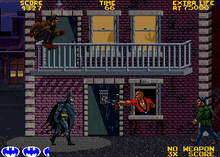
Batman is a 1989 superhero film based on the DC Comics character of the same name, created by Bob Kane and Bill Finger. Directed by Tim Burton, it is the first installment of Warner Bros.' initial Batman film series. The film was produced by Jon Peters and Peter Guber and stars Jack Nicholson, Michael Keaton, Kim Basinger, Robert Wuhl, Pat Hingle, Billy Dee Williams, Michael Gough, and Jack Palance. The film takes place early in the title character's war on crime and depicts his conflict with his archenemy the Joker.
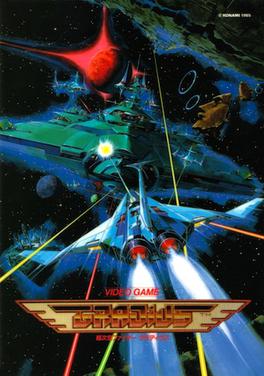
Gradius is a side-scrolling shooter video game developed and published by Konami. The first game in the Gradius series, it was originally released as a coin-operated arcade game in 1985. The player maneuvers a spacecraft known as the Vic Viper that must defend itself from the various alien enemies. The game uses a power-up system called the "power meter", based upon collecting capsules to purchase additional weapons.

Pong is a table tennis–themed twitch arcade sports video game, featuring simple two-dimensional graphics, manufactured by Atari and originally released on 29 November 1972. It is one of the earliest arcade video games; it was created by Allan Alcorn as a training exercise assigned to him by Atari co-founder Nolan Bushnell, but Bushnell and Atari co-founder Ted Dabney were surprised by the quality of Alcorn's work and decided to manufacture the game. Bushnell based the game's concept on an electronic ping-pong game included in the Magnavox Odyssey, the first home video game console. In response, Magnavox later sued Atari for patent infringement.
A sports video game is a video game that simulates the practice of sports. Most sports have been recreated with video games, including team sports, track and field, extreme sports, and combat sports. Some games emphasize playing the sport, whilst others emphasize strategy and sport management. Some, such as Need for Speed, Arch Rivals and Punch-Out!!, satirize the sport for comic effect. This genre has been popular throughout the history of video games and is competitive, just like real-world sports. A number of game series feature the names and characteristics of real teams and players, and are updated annually to reflect real-world changes. The sports genre is one of the oldest genres in gaming history.

Frogger is a 1981 arcade action game developed by Konami and published by Sega. In North America, it was distributed by Sega/Gremlin. The object of the game is to direct five frogs to their homes by dodging traffic on a busy road, then crossing a river by jumping on floating logs and alligators.
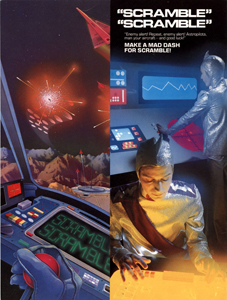
Scramble is a horizontally scrolling shooter arcade video game released in 1981. It was developed by Konami and manufactured and distributed by Leijac in Japan and Stern in North America. It was the first side-scrolling shooter with forced scrolling and multiple distinct levels, and it established the foundation for a new genre.

Contra is a 1987 run and gun video game developed and published by Konami for arcades. A home version was released for the Nintendo Entertainment System in 1988, along with ports for various home computer formats, including the MSX2. The arcade and computer versions were localized as Gryzor in Europe, and the NES version as Probotector in PAL regions and France.
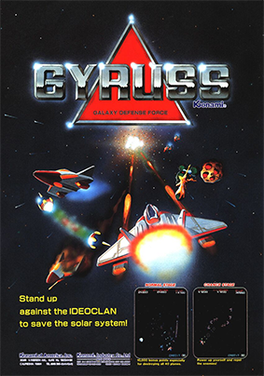
Gyruss is shoot 'em up arcade video game designed by Yoshiki Okamoto and released by Konami in 1983. Gyruss was initially licensed to Centuri in the United States for dedicated machines, before Konami released their own self-distributed conversion kits for the game. Parker Brothers released contemporary ports for home systems. An enhanced version for the Family Computer Disk System was released in 1988, which was released to the North American Nintendo Entertainment System in early 1989.

Track & Field, also known as Hyper Olympic in Japan and Europe, is an Olympic-themed sports video game developed by Konami and released as an arcade video game in 1983. The Japanese release featured an official license for the 1984 Summer Olympics. In Europe, the game was initially released under the Japanese title Hyper Olympic in 1983, before being re-released under the US title Track & Field in early 1984.
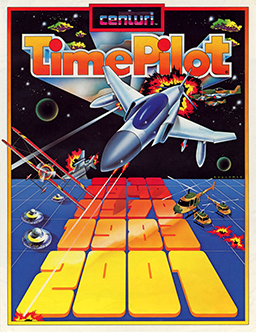
Time Pilot is a multidirectional shooter arcade video game designed by Yoshiki Okamoto and released by Konami in 1982. It was distributed in the United States by Centuri, and by Atari Ireland in Europe and the Middle East. While engaging in aerial combat, the player-controlled jet flies across open airspace that scrolls indefinitely in all directions. Each level is themed to a different time period. Home ports for the Atari 2600, MSX, and ColecoVision were released in 1983.

Pac-Land is a 1984 side-scrolling arcade platform game developed and released by Namco. It was distributed in North America by Bally Midway, and in Europe by Atari Games. Controlling Pac-Man, the player must make it to the end of each stage to return a lost fairy back to its home in Fairyland. Pac-Man will need to avoid obstacles, such as falling logs and water-spewing fire hydrants, alongside his enemies, the Ghost Gang. Eating large flashing Power Pellets will cause the ghosts to turn blue, allowing Pac-Man to eat them for points.
The following article is a broad timeline of arcade video games.

Rush'n Attack, also known as Green Beret in Japan and Europe, is a run-and-gun and hack-and-slash video game developed and released by Konami for arcades in 1985, and later converted to the Nintendo Entertainment System and home computers. Its North American title is a play on the phrase "Russian attack" due to its Cold War setting. It was ported to home systems and became a critical and commercial success for arcades and home computers.

Galaga '88 is a 1987 fixed shooter arcade video game developed and published in Japan by Namco and in North America and Europe by Atari Games. It is the third sequel to Galaxian. It features significantly improved graphics over the previous games in the series, including detailed backgrounds, larger enemies and greater ship details. The game runs on Namco System 1 hardware.
Centuri, formerly known as Allied Leisure, was an American arcade game manufacturer. They were based in Hialeah, Florida, and were one of the top six suppliers of coin-operated arcade video game machinery in the United States during the early 1980s. Centuri in its modern inception was formed when former Taito America president Ed Miller and his partner Bill Olliges took over Allied Leisure, Inc. They renamed it "Centuri" in 1980.

Loco-Motion, known as Guttang Gottong in Japan, is an arcade puzzle game developed by Konami in 1982 and released by Sega in Japan. The North American rights were licensed to Centuri. In Loco-Motion, the player builds a path for their unstoppable locomotive by moving tracks which will allow it to pick up passengers.

The Joker, a supervillain in DC Comics and archenemy of the superhero Batman, has appeared in various media. WorldCat records over 250 productions featuring the Joker as a subject, including films, television series, books, and video games. Live-action films featuring the character are typically the most successful.

Batman: The Video Game is a video game developed by Sunsoft for the Nintendo Entertainment System featuring the DC Comics character Batman, loosely based on the 1989 film of the same name. The game is a platformer featuring five levels. Sunsoft developed three related games with the same title for the Game Boy, Sega Genesis/Mega Drive, and PC Engine in 1990.
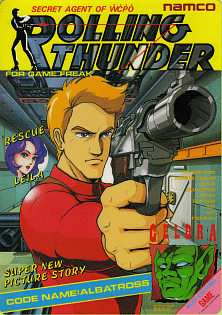
Rolling Thunder is a run and gun video game developed by Namco in Japan and Europe and released in 1986 as a coin-operated arcade video game using the Namco System 86 hardware. It was distributed in North America by Atari Games. The player takes control of a secret agent who must rescue his female partner from a terrorist organization. Rolling Thunder was a commercial success in arcades, and it was released for various home computer platforms in 1987 and the Nintendo Entertainment System in 1989. The original arcade game has been included in various classic game compilations as well. It influenced later arcade action franchises such as Shinobi and Time Crisis, which borrowed mechanics such as taking cover behind crates. On March 17, 2022, the arcade version of the game got ported as part of the Arcade Archives series.

Teenage Mutant Ninja Turtles, released in Japan as Teenage Mutant Ninja Turtles: Super Kame Ninja and in Europe as Teenage Mutant Hero Turtles, is a 1989 beat 'em up game developed and published by Konami for arcades. It is based on the Teenage Mutant Ninja Turtles franchise, including the first animated series that began airing two years earlier. In the game, up to four players control the titular Ninja Turtles, fighting through various levels to defeat the turtles' enemies, including the Shredder, Krang and the Foot Clan. Released during a high point in popularity for the Teenage Mutant Ninja Turtles franchise, the arcade game was a worldwide hit, becoming the highest-grossing dedicated arcade game of 1990 in the United States and Konami's highest-grossing arcade game. Versions for various home systems soon followed, including the Nintendo Entertainment System. A sequel, Teenage Mutant Ninja Turtles: Turtles in Time, was released in 1991.

